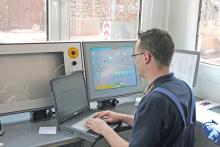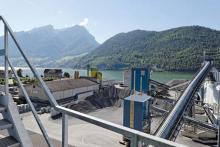
Automation in quarries is on the increase, and is said to help improve production while monitoring vital functions. Patrick Smith reports.
An automation system in the primary crusher at Pedreira Guaravera, that is said to have increased production by 40%, has been implemented by
It is also said to have eliminated bottlenecks in the crushing line and provided greater homogeneity in production as well as better control over the process.
Situated in the north of Paraná state, Brazil, Pedreira Guaravera has always stood out for its focus on products of higher quality and added value, directing its service to the concrete companies in the region, which demand a more cubical crushed stone and strict control of the particle size range.
This strategy guided the configuration of its crushing line, which until recently had a cone crusher in the secondary stage and a VSI (vertical shaft impactor) crusher in the tertiary stage.
“Although we obtained a homogeneous material in terms of particle size, this generated many fines in the process and represented a problem for our operation due to the lack of demand for this product in the market,” says Rodrigo Bastos, managing partner of Guaravera.
The solution to the problem was presented by Metso, who proposed replacing the VSI crusher with a Nordberg HP400 model, shifting the old cone crusher from the secondary to the tertiary stage, with proper replacement of the linings used.
“We also installed new screens for better classification of the material, getting a productivity gain, as well as eliminating the liabilities that the generation of a large amount of fines represented,” says Bastos.
“However, the primary jaw crusher became too small for our operation and began to pose a bottleneck to the process.”
According to Bastos, the current market situation did not support investments in a new primary crusher. So Metso offered the solution by proposing crushing plant automation, a cost-effective alternative.
“With Metso’s technical assistance, the system was implemented quickly and smoothly, enabling a 40% increase in the production of the primary crusher,” says Bastos.
Basically, the technology used consists of sensors connected to an automation system that controls crushing feeding; manages the discharge of the trucks in the hopper, and monitors the crusher bearing temperature.
The whole process is monitored by the operator using a display located in the control cabin, and the system generates operation and production reports.
“We implemented the system looking for greater productivity and gained additional benefits, such as a unique standard in the material produced, regardless of the operator’s ability in the cabin, and a set of information that gives us reliability for decision-making,” says Bastos.
Productivity and homogeneity gains in the product size range are due to the new sensors used to control feeding speed, causing the crusher to work with the crushing chamber at capacity most of the time, without overloading the crushing plant.
Without this control, feed control was exclusively an operator’s task, which used to result in variations in the volume processed and, consequently, in the quality of the material produced. In addition, the sensor installed over the hopper is used to control the traffic lights that manage the unloading of the trucks, improving the flow of material coming from the mine.
With the new system, Guaravera increased the transportation fleet between the mine and the primary crusher from two to three trucks, which now operates below the maximum load.
“In this way, we maintain a constant cycle of operation and eliminate the unproductive time of trucks waiting, both for loading at the mine and unloading into the crusher,” says Bastos.
Prior to the plant automation, the quarry operated with an average of 50-60 truck trips/day, which increased to about 120 trips, allowing a continuous production flow.
Bastos also emphasises that the system generates a set of important information for the management of the business, such as the time the equipment is operating effectively, whether it is working under load or not, and how many times the hydraulic arm is operated, as well as the time used in its operation.
“Before, we had manual reports, but now the data is generated automatically and in real-time, giving us better reliability and allowing for faster decision-making.”
He explains that if, for example, the hydraulic arm is being excessively used, he immediately intervenes in the mine operation to improve blasting quality.
The system includes crusher bearing temperature sensors to help the maintenance management, and these are used for detecting deviations and anticipating problems.
“If the temperature rises above the specified standards, the quarry can go under a scheduled shutdown before the defect compromises other components and requires corrective action, impacting its operation,” says Fernando Bicalho, senior automation engineer at Metso.
He explains that the system stores operation and production information for a week, but preparations are being made to connect it to a more robust, plant-wide management platform in the future.
“When you talk about plant automation, people think about a major refurbishment or the installation of new equipment, but we are prepared to offer a solution tailored to the needs of each operation.”
Bicalho points out that Metso offers all the technical support for implementing the automation system, for equipment supplied by the company as well as from other brands, reducing the installation time and the impact on customer operations. In the case of Pedreira Guaravera, for example, the assistance offered by Metso included everything from the installation of the sensors and other devices to the necessary adjustments to the electrical system and motor.
In another application, Elite Control Systems, a provider of systems integration services, used wireless technology to provide a solution for one of its key clients.
The system was installed on large stacker and reclaimer machines located in a remote part of Tarmac’s Dunbar site in Scotland.
Raw material is transferred from the quarry onto the conveyor system that feeds into the stacker, which stacks the product in an even pile in readiness for future reclamation by the reclaimer, which in turn feeds the raw mill.
The unmanned stacker and reclaimer machines are in a remote area of the cement works and travel along a rail track, creating a consistent accumulation of raw material.
The stacker will continue to transfer the raw material onto a uniform stockpile until it senses that the level of product has reached its required height. Once a pile has been built, it will be reclaimed by the reclaimer and mixed with other raw materials before being ground into a raw meal in the raw mill.
When Tarmac asked Elite Control Systems to assist Siemens in providing it with a way to monitor both the stacker’s and the reclaimer’s activities through the plant’s existing control system, Elite devised a custom solution.
The standard way of connecting to remote machines, such as tarmac’s stacker and reclaimer, would normally involve running new cables in what can often be considered an expensive and disruptive installation procedure.
By utilising a wireless solution, most of this type of installation work was not required, although the application did call for a thorough preliminary assessment involving an initial wireless audit, which was essential to ensure that the wireless solution could be implemented successfully in this instance.
Working closely alongside the manufacturer of the wireless equipment, Elite Control Systems carried out the wireless assessment of the area where the new system would be installed. Elite then proceeded to install the specified Siemens Scalance wireless communication system.
In this instance, the appropriate Industrial Wireless LAN (Scalance W786) components that comply with the required IEEE 802 standards were installed.
The work involved mounting the necessary wireless communication equipment at suitable points on the plant, which then continuously transmits signals directly from the machines.
This effectively provides the necessary status information and makes it possible for plant engineers to remotely monitor the desired machine parameters.
By further integrating this system into Tarmac’s existing site network, the status of the stacker and reclaimers is now able to be visually displayed in the main pcs7 system control room.
FLSmidth says its QCX/BlendExpert product range has been expanded with AQL, which extends the functionality of QCX/BlendExpert-Pile into the quarry area.
“The optimisation features of QCX/BlendExpert-Pile deliver dynamically updated optimal feed proportions and feed rates to the crusher(s),” says FLSmidth.
“Realisation of the optimal feed rates typically involves verbal instructions on how ‘much material from where’ from the crusher control room personnel to the dumper drivers. With AQL this information flow is automated.”
The AQL basic software supports wireless data export of the calculated optimal feed proportions to a data display unit mounted in the dumpers. More advanced options support dumper drivers feeding relevant data back to the crusher control room personnel and to the QCX/BlendExpert-Pile software.
The company says the AQL-GPS option adds smart functionality, which tracks dumper traffic in the quarries, while AQL_Excavation adds advanced excavation optimising features, the most important one being to select the optimum combination of quarry benches at any given time. This optimisation is based on such data as active quarry benches, their distance to the crusher(s), the number of dumpers and front loaders and cost of material.









